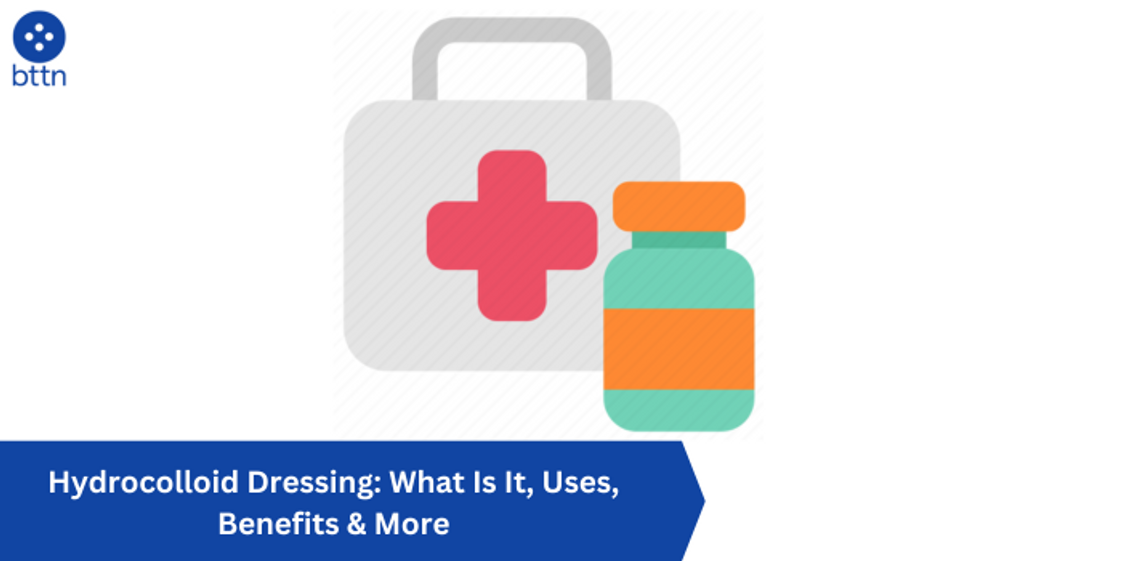
Hydrocolloid Dressing: What Is It, Uses, Benefits & More
Posted by Pankaj Dhiman on Dec 6th 2024
In the realm of wound care, hydrocolloid dressings have emerged as a revolutionary solution offering a multitude of benefits. But what exactly are hydrocolloid dressings, and why are they gaining popularity in medical circles? In this comprehensive guide, we delve into the world of hydrocolloid dressings, exploring their uses, benefits, applications, and addressing frequently asked questions.
Shop Now - Hydrocolloid Dressing
What is a Hydrocolloid Dressing?
Let's start with the basics. A hydrocolloid dressing is a type of wound dressing made of gel-forming agents, such as gelatin or sodium carboxymethylcellulose, embedded in a flexible, water-resistant adhesive. These dressings are designed to create a moist environment around the wound, promoting faster healing while protecting the wound from external contaminants.
Must Read: Alginate Wound Dressing: Uses, Importance, Benefits, Application, FAQs
What is an Example of a Hydrocolloid Dressing?
One popular example of a hydrocolloid dressing is Duoderm, a brand known for its high-quality adhesive dressings. Duoderm dressings are widely used in medical settings and are renowned for their effectiveness in wound management.
Must Read: Silicone Dressings: Uses, Benefits, Application
Uses of Hydrocolloid Dressing
Hydrocolloid dressings find application in a diverse range of wounds, including:
- Pressure Ulcers: These dressings are highly effective in managing pressure ulcers, providing cushioning and promoting healing.
- Minor Abrasions and Cuts: Hydrocolloid dressings can be used to cover minor cuts and abrasions, providing a protective barrier against bacteria and other pathogens.
- Burns: They are suitable for managing minor burns, offering pain relief and aiding in the healing process.
- Surgical Wounds: Hydrocolloid dressings are often used post-surgery to cover incisions and promote wound healing.
Must Read: Best Selling Bouffant Caps in the US 2024
Importance of Hydrocolloid Dressing
The significance of hydrocolloid dressings lies in their ability to create an optimal healing environment for wounds. By maintaining a moist environment, these dressings facilitate the natural healing process while preventing the wound from drying out and forming a scab. Additionally, the adhesive nature of hydrocolloid dressings ensures that they stay in place, providing continuous protection to the wound.
Shop Now - Transparent Dressing
Benefits of Hydrocolloid Dressing
Some key benefits of using hydrocolloid dressings include:
- Promotes Faster Healing: By creating a moist environment, hydrocolloid dressings accelerate the healing process, reducing the risk of infection and scarring.
- Provides Pain Relief: The cushioning effect of hydrocolloid dressings helps alleviate pain associated with wounds, promoting patient comfort.
- Protects Against Contamination: These dressings form a barrier against bacteria and other external contaminants, reducing the risk of wound infection.
- Convenient Application: Hydrocolloid dressings are easy to apply and can be left in place for several days, minimizing the need for frequent dressing changes.
Must Read: Top 5 Best Selling Hypoallergenic Tapes in the US 2024
Application of Hydrocolloid Dressing
Applying a hydrocolloid dressing is a straightforward process:
- Clean the Wound: Thoroughly clean the wound and surrounding skin with mild soap and water. Pat the area dry.
- Select the Right Size: Choose a hydrocolloid dressing that matches the size of the wound, ensuring adequate coverage.
- Peel and Apply: Peel off the backing of the dressing and carefully apply it over the wound, ensuring proper adhesion.
- Monitor Regularly: Check the dressing regularly for signs of leakage or infection. Replace as needed or as directed by a healthcare professional.
Must Read: Top 5 Cardinal Health Foley Catheters for 2024
Important Considerations for Hydrocolloid Dressing
While hydrocolloid dressings offer numerous benefits, there are some important considerations to keep in mind:
- Not Suitable for Infected Wounds: Hydrocolloid dressings are not recommended for use on infected wounds as they may trap bacteria and exacerbate the infection.
- Allergic Reactions: Some individuals may be allergic to the adhesive components of hydrocolloid dressings. Monitor for any signs of allergic reactions, such as redness or itching.
- Consult a Healthcare Professional: Always consult a healthcare professional for guidance on the appropriate use of hydrocolloid dressings, especially for complex or chronic wounds.
FAQs
Q: How long can a hydrocolloid dressing stay on?
A: Hydrocolloid dressings can typically stay on for several days, depending on the individual's wound and the manufacturer's recommendations. However, it's essential to monitor the dressing regularly and change it if it becomes soiled or loses adhesion.
Q: Can hydrocolloid dressings be used on sensitive skin?
A: Yes, hydrocolloid dressings are generally safe for use on sensitive skin. However, individuals with known allergies should exercise caution and consult a healthcare professional if any adverse reactions occur.
Q: Are hydrocolloid dressings waterproof?
A: While hydrocolloid dressings are water-resistant, they may not be entirely waterproof. It's essential to avoid prolonged exposure to water to prevent the dressing from loosening or losing adhesion.
Q: Can hydrocolloid dressings be cut to size?
A: Yes, hydrocolloid dressings can be easily cut to size using sterile scissors to fit the specific dimensions of the wound.
Shop Now - Wound Closure
Final Word
Hydrocolloid dressings represent a significant advancement in wound care, offering a multitude of benefits for patients and healthcare providers alike. By creating an optimal healing environment, providing pain relief, and protecting against infection, these dressings play a crucial role in the management of various types of wounds. However, it's essential to use them judiciously and seek professional guidance when necessary to ensure optimal outcomes. Whether you're dealing with a minor abrasion or a surgical wound, consider the potential benefits of hydrocolloid dressings in promoting faster healing and optimal wound care.
